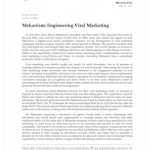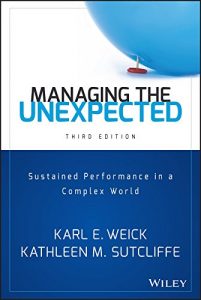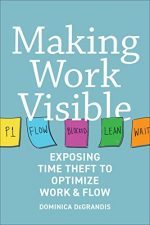 I spent a year writing case studies before I began my doctoral program. More accurately, I was required to spend a year as a case writer to demonstrate my qualifications and commitment to the program before the admissions committee would accept me. My academic transcripts showed a bit more variance than the committee was accustomed to seeing and this was the compromise between the advisor who believed in me and the committee.
I spent a year writing case studies before I began my doctoral program. More accurately, I was required to spend a year as a case writer to demonstrate my qualifications and commitment to the program before the admissions committee would accept me. My academic transcripts showed a bit more variance than the committee was accustomed to seeing and this was the compromise between the advisor who believed in me and the committee.
The first case I wrote dealt with Gillette and their efforts to figure out how to manage electronic data interchange with their customers. At the time this was a leading edge issue for IT organizations. I went with my advisor to our first set of interviews on the South Side of Boston. He took three quarters of a page of notes at most; I was scribbling furiously to keep up.
The next day, we met to review what we had learned and my advisor’s first question was “where is your trip report?†My blank expression would not have been an encouraging sight to the admissions committee; my advisor was more forgiving.
What he expected and explained to me was to see my semi-legible and partial notes transformed into a coherent reaction to the previous day’s interview. If I was to eventually create a case study that would work in the classroom or extend our understanding of this issue, I needed to get my thinking out of my head and available for inspection, by myself first and foremost.
HBS believes deeply in the value of learning by doing. The case method immerses you in management and decision situations and you figure out what to do in the middle of the same mess and confusion you will later work in. You learn to write cases in the same way—in the mess and confusion. The challenge is to discover the appropriate threads and themes without overwhelming what is there with your biases and preconceptions. Richard Feynman captured this challenge most succinctly thusly: “the first principle is that you must not fool yourself — and you are the easiest person to fool.†The discipline and practice of transforming raw interview notes into a trip report turns out to be a simple and useful technique for avoiding that trap.
After a good stretch of this learning by doing, I did discover that this approach exists in its own rich context, as does any fundamentally useful technique. Anthropologist Clifford Geertz called it “thick description,†Sociologists Barney Glaser and Anselm Strauss called it “grounded theory.â€
I thought I was developing my skills to do organizational research. What I was also doing was developing a set of transferable knowledge work skills. I was laying the foundations of my personal knowledge management practices.
I’ve written before about the challenge of solving for pattern, which is a core requirement of knowledge work. This demands a respect for the richness of what is going on out in the world. We are pattern seeking/pattern recognizing creatures; our early survival depended on our ability to notice, extract, and react to patterns quickly. If we mistake a stick for a snake, there is little penalty; if we reach for a stick that turns out to be a snake, we die. Those instincts can be a problem in less threatening environments. In modern settings, imposing a bad pattern on data means missed opportunities; not death.
Our modern task is to get better at noticing what is interesting. We need to temper our instincts to instantly match a pattern and strive to remain grounded in the details that make up the phenomenon we wish to understand. What was once an essential research task is now a day-to-day requirement for the average knowledge worker.
What makes this tricky is that we don’t often know, at the outset, what constitutes the phenomena we are interested in. There is no easy way to separate the phenomena you are interested in from the surrounding environment and context. We may also not be able to easily differentiate between objective phenomena and our subjective reactions. Rather than pursue an unobtainable objective stance, we simply acknowledge and include our subjective responses as part of the package of data.
More often than not, this package of data—interview notes, trip report, exhibits—is only interesting to the individual knowledge worker; it is not yet a final deliverable for sharing. But the collection is worth keeping and organizing for two reasons. First, it provides an audit trail and supporting materials for whatever final deliverable does get produced. Second, it becomes a resource for future work.
As knowledge workers our value is built on a body of work that accumulates over time. We can make that body of work more valuable to ourselves and, therefore, to our organizations by becoming more systematic in how we create, assemble, and manage it.



 Had lunch with my friend Buzz Bruggeman, CEO of
Had lunch with my friend Buzz Bruggeman, CEO of 
 When people ask me why I did something so strange as to leave a perfectly good career and get a Ph.D., the story I tell is this.
When people ask me why I did something so strange as to leave a perfectly good career and get a Ph.D., the story I tell is this. The
The  A common formulation in analytics circles is data yields insights which provoke action. Stripped to the core, this is the marketing pitch for every vendor of analytics or information management tools. This pitch works because people drawn to management prefer the action end of that cycle and are inclined to do no more analysis than necessary to justify an action. “Don’t just stand there, do something!†is a quintessential managerial command (and the exclamation point is required).
A common formulation in analytics circles is data yields insights which provoke action. Stripped to the core, this is the marketing pitch for every vendor of analytics or information management tools. This pitch works because people drawn to management prefer the action end of that cycle and are inclined to do no more analysis than necessary to justify an action. “Don’t just stand there, do something!†is a quintessential managerial command (and the exclamation point is required).